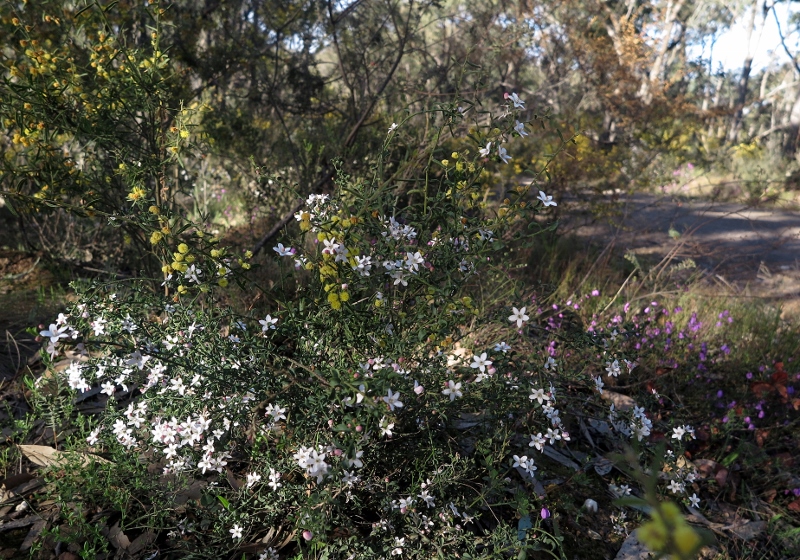As we reported on August 16, DELWP is planning to create fuel breaks in this region, both near settlements and through bushland: ‘Strategic Fuel Breaks are a strip of land where vegetation has been permanently modified to reduce the rate of spread and intensity of fire for the direct protection of assets and/or assist fire control.’ (FOBIF emphasis).
The breaks will generally be along tracks or roads. They could be up to 40 metres wide, including the width of the roads, though in our region they may be narrower. There is some confusion about how they’ll look: some documents say that they are mown down and mulched to 10 centimetres, others that they can resemble ‘open grassy wood or heath lands.’ The difference is important: no heathland would survive being mown and mulched to 10 centimetres. We’re hoping to clear up exactly what is meant by the breaks proposed for our region.
Some of the proposed breaks are centred around Castlemaine and Chewton, others are planned for the Fryers Forest and the Diggings Park, including Fryers Ridge road and Porcupine Ridge road.
Last Monday the FOBIF committee adopted the following position on the breaks:
- Fuel breaks near settlements are in principle a good idea, consistent with the principle of giving priority importance to human life.
- Thinning of bush roadside trees, and removal of hazardous ones, is a sensible safety measure, if properly done
- The mulching of bush tracksides is a serious biodiversity and amenity risk. Each trackside should be treated on its merits, but we believe that mulching the Fryers Ridge and Porcupine Ridge road verges would be
–an amenity catastrophe: the status of the roads as wildflower hotspots will be perhaps definitively damaged. We believe that the view shown in the above photo will no longer be seen along these roads.
–a very serious reduction of biodiversity value for the whole of those forests, regardless of the protection offered to pockets of endangered species.
FOBIF is acutely aware of the risks posed by fire in a warming climate. We believe, however, that fire protection measures should be undertaken with every effort made to avoid damage to natural systems. There’s not much point in destroying the village to save it.
Is it possible to manage vegetation along major bush roads so as to ensure firefighter safety, without reducing vegetation to a lawn? We hope so.
So far, consultations between local environment groups and the fuel breaks team have been constructive. We hope they continue that way.





 Click on image for info/order page
Click on image for info/order page Click on image for info/order page
Click on image for info/order page Click on image for info/order page
Click on image for info/order page





















This is a very serious concern. As the FOBIB has written, the creation of fire breaks has the potential to harm floral biodiversity, and I can at least point to one taxon: the prostrate Fryerstown Grevillea (Grevillea obtecta).
Three Honours students from La Trobe (including myself) have worked on this endemic species a decade ago, and we have surveyed Porcupine Ridge and Fryers Ridge NCR areas in some detail. We have recorded several populations of the grevillea on road embankments, particularly along Porcupine Ridge Road north of Middleton Creek, and along Dearden Track west of Taradale.
I have also surveyed the area bound by Porcupine Ridge Road and Wewak Track that was back-burned some time ago, and I found that the population size of the Fryerstown Grevillea was drastically reduced, possibly from the dense regeneration of wattles and Daphne Heath (Brachyloma daphnoides) that cast deep shade over what was once a healthy population of Fryerstown Grevillea.
How the fuel breaks will be created will affect the viability of the species. Thinning of roadside trees may prompt the growth and recruitment of the species, but soil disturbance (e.g. track widening or mulching) will surely extirpate those individuals on road embankments, and I believe that there are already not too many left of the species.
In my opinion, we don’t know enough of the ecology and biology of the Fryerstown Grevillea and many other species to justify major fuel reduction exercises.
Totally agree with Gerry. Fire may not be as important to some plant species as it is for others in germination. Others may need different environmental opportunities like soil disturbance.
When I’m observing many Grevillea species in the wild, I find them near previously disturbed ground, like near roadsides and tracks, as if seeds have needed soil disturbance in order to propagate. I imagine that species like Grevillea obtecta, with close to the ground flowers were in some symbiotic relationship with small kangaroo marsupials like bandicoots for example. I wonder if anyone else comes to similar conclusions?